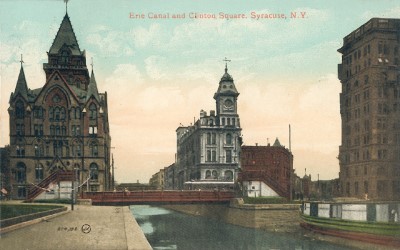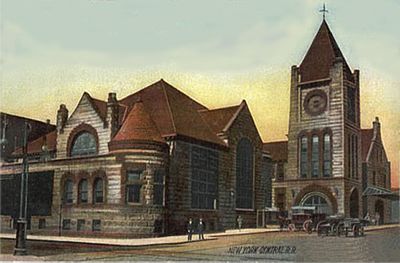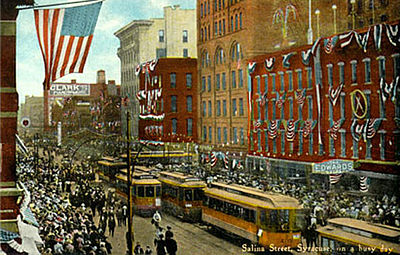Syracuse is a city in, and the county seat of, Onondaga County, New York, in the United States. It is the largest U.S. city with the name “Syracuse”, and is the fifth most populous city in the state of New York following New York City, Buffalo, Rochester, and Yonkers. At the 2010 census, the city population was 145,170, and its metropolitan area had a population of 662,577. It is the economic and educational hub of Central New York, a region with over a million inhabitants. Syracuse is also well-provided with convention sites, with a downtown convention complex. Syracuse was named after the original Greek city Syracuse (Siracusa in Italian), a city on the eastern coast of the Italian island of Sicily.
Year 1910. City of Syracuse. Salina Street Parade.
The city has functioned as a major crossroads over the last two centuries, first between the Erie Canal and its branch canals, then of the railway network. Today, Syracuse is located at the intersection of Interstates 81 and 90, and its airport is the largest in the region. Syracuse is home to Syracuse University, a major research university, as well as Le Moyne College, a nationally recognized liberal arts college. In 2010, Forbes rated Syracuse 4th in the top 10 places in the U.S. to raise a family.
The Syracuse area was first seen by Europeans when French missionaries came to the area in the 1600s. At the invitation of the Onondaga Nation, one of the five constituent members of the Iroquois confederacy, a group of Jesuit priests, soldiers, and coureurs des bois (including Pierre Esprit Radisson) set up a mission, known as Sainte Marie among the Iroquois, or Ste. Marie de Gannentaha, on the northeast shore of Onondaga Lake.
Jesuit missionaries visiting the Syracuse region in the mid 1600s reported salty brine springs around the southern end of “Salt Lake”, known today as Onondaga Lake. The 1788 Treaty of Fort Stanwix, and the subsequent designation of the area by the state of New York as the Onondaga Salt Springs Reservation provided the basis for commercial salt production from the late 1700s through the early 1900s; brine from wells that tapped into halite (common salt) beds in the Salina shale near Tully, New York, 15 miles south of the city were developed in the 19th century.

Year 1910. City of Syracuse. Erie Canal and Clinton Square.
It is the north flowing brine from Tully that is the source of salt for the “salty springs” found along the shoreline of Onondaga lake. The rapid development of this industry in the 18th and 19th centuries led to the nicknaming of Syracuse as “The Salt City”. In 1847, the city was officially named after Syracuse, Sicily, which at the time was also famous for its salt mining industry.
The first Solvay Process Company plant in the United States was erected on the southwestern shore of Onondaga Lake in 1884 and the village was given the name Solvay, New York to commemorate its inventor, Ernest Solvay. In 1861, he developed the ammonia-soda process for the manufacture of soda ash (anhydrous sodium carbonate, a rare chemical called natrite, to distinguish it from natural natron of antiquity) from brine wells dug in the southern end of Tully valley (as a source of sodium chloride) and limestone (as a source of calcium carbonate). The process was an improvement over the earlier Leblanc process. The Syracuse Solvay plant was the incubator for a large chemical industry complex owned by Allied Signal in Syracuse, the result of which made Onondaga Lake the most polluted in the nation.

Year 1910. City of Syracuse. Train station.
The salt industry declined after the Civil War, but a new manufacturing industry arose in its place. Throughout the late 1800s and early 1900s, numerous businesses and stores were established, including the Franklin Automobile Company, which produced the first air-cooled engine in the world; the Century Motor Vehicle Company; and the Craftsman Workshops, the center of Gustav Stickley’s handmade furniture empire.

